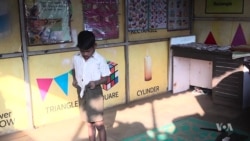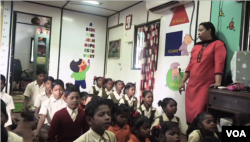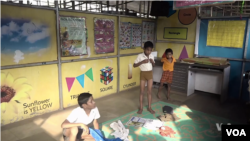There are an estimated one million street children in India and about 46 of them are going to school in a shipping container located under a major underpass in a town bordering Mumbai in India.
Since children on the street won't go to regular school, authorities brought the classroom to where they spend much of the day – on the streets.
Students don their uniforms as soon as they arrive for class in the remodeled shipping container under a busy traffic intersection in Thane.
The children of homeless parents, the students had never attended school until they came here, according to Batu Sawant, who heads the voluntary group Samarth Bharat Vyaspith, which runs the Signal School along with civic authorities.
“People who live on the streets will not dress up their children and send them to school or pick them up in the afternoon," Sawant says. "So it was necessary to bring the school to them.”
Since the school began a year and a half ago, enrollment is up from 22 to 46. The students used to sell trinkets at traffic signals or beg on the streets, but now they spend the day catching up on their education.
Teacher Shradha Dandavate says it was a challenge to make children who grew up coping with the rough-and-tumble of street life to trade habits like fighting and cursing for learning to write and read.
“They are not accustomed to school," she says. "They get bored and desperate to resume their earlier lives. But slowly through stories, songs, playing, we got them used to spending the day in school.”
The school has adapted to the lifestyle of the homeless, opening at 10 a.m. because children go to sleep late after the incessant traffic noise dies down. It provides lockers to store books and uniforms that are not safe on the street. The students are given nutritious supplements and lessons in hygiene and grooming.
But the transformation goes beyond appearances.
“It ended begging," Sawant says. "That helped change their mindset that you get things free by just asking. Education has taught them that you can work hard and have a good career.”
Although a latecomer to school, the oldest student, 19-year-old Mohan Kale, is confident of cracking the Grade X examination this year.
“What to do in the world, how life should be lived, I have learned everything in school, that is why I like it here,” Kale says.
Ambitions and dreams are being kindled at the school.
“I will study very well and become an important man,” says student Kiran Chandrakant Kale.
The Signal School is a small initiative aimed at ushering in change one step at a time. Sawant has asked authorities for two more containers and a bus to ferry in children from other traffic intersections to join the school.















